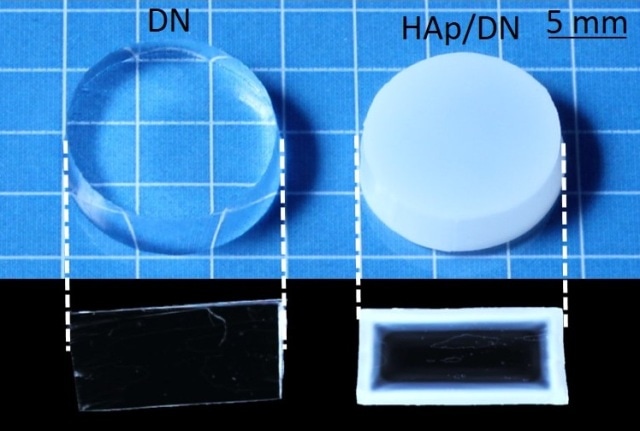Jul 18 2016
A new variety of hydrogel has been developed by Hokkaido University researchers. This new hydrogel can be used to treat joint injuries as it is capable of bonding firmly and spontaneously to defected bones.
 The DN gel (left) and the newly developed HAp/DN gel (right) and their cross sectional views. (Nonoyama T., Wada S. et al., Advanced Materials, May 17, 2016)
The DN gel (left) and the newly developed HAp/DN gel (right) and their cross sectional views. (Nonoyama T., Wada S. et al., Advanced Materials, May 17, 2016)
Soft supporting human tissues, such as ligaments and cartilage, are joined strongly to the bones. These tissues fail to repair spontaneously inside the body when they are damaged. Artificial supporting tissues are capable of ameliorating damage to soft tissues. However, until now progress has been hindered by the insufficiency of materials that are firm, yet flexible and soft, for sticking to the bone.
Earlier, the researchers invented a high-strength, strong network gel known as double-network gel (DN gel), which showed superior performance such as inductive function for cartilage regeneration and low wear rate. This gel had difficulty in adhering to other surfaces as its key component was water. This indeed is a major drawback in its practical application.
This issue was resolved with the newly developed gel. The research group added the main inorganic component of bone known as hydroxyapatite (HAp) to the DN gel’s surface by dipping it in solutions of phosphate and calcium. This was followed by transporting the HAp-coated DN gel into a rabbit’s defected bone. After four weeks, the team detected that the gel has firmly bonded to the rabbit’s bone unlike the non-coated gel that completely failed to bond. Electron-microscopic analysis pointed out that the newly developed bone component in the area that is defected had deeply traveled into the surface of the gel and then seamlessly blended to it.
Strong, nontoxic hydrogel that firmly fixes to the bone is a great improvement in the treatment of injuries related to joint and soft tissues. The research findings prove to be promising for the application of string hydrogel materials as cartilage.
The bonding between HAp/DN gel and bone mimics physiological bonding seen with cartilage, ligament and tendon, causing less stress to the body. We expect that the gel could be used to firmly attach artificial ligament or tendon to bone.
Jian Ping Gong, Lead Author
The work was supported by Hokkaido University’s Global Institution for Collaborative Research and Education (GI-CoRE).